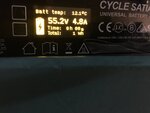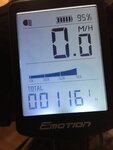The best place to learn about this is on Grin's website, here's a link-
Like i said first referring to your inaccurate statement :
"Satiator has hard limits for amps, volts, and watts which take effect depending on where you are in the charge cycle"
- you either took the wrong assumption about it or you haven't studied good enough the articles in the above website about this device.
The limit is OVER RIDDEN using the custom profiles.
Read this again and let in sink in:
Once the voltage limit is changed for say the 48v (54.6 up to 55.2 or 55.6v) , it can keep charging at a high rate(6amps) all the way up to 95-97%.
NO hard limits anylonger at a certain voltage !
Do it on yours and you'll understand what i'm talking about.
But you must know your cells for the 48v pack and don't let them go over 4.3V. Some are 4.1v.
ex: in pic pack is @95% , profile set for 55.2v for a 48v (is fine as long as you know what specific cells your pack has and stop charge once it reaches 97-100%) . It could be set as high as 55.6v for a 6.2ah rate all the way up to 100%.
Had i not adjusted the profile and let it use the common 54.6voltage, those hard limits you've mentioned would have taken precedent.
As soon as it reached 80%, charge rate would have been 4ah , compared to 6.2ah.
And as you know it would have dropped down all the way to 2amps at 90%. No good !!
That's why they made this charger with many settings. But you must know what you're doing.


